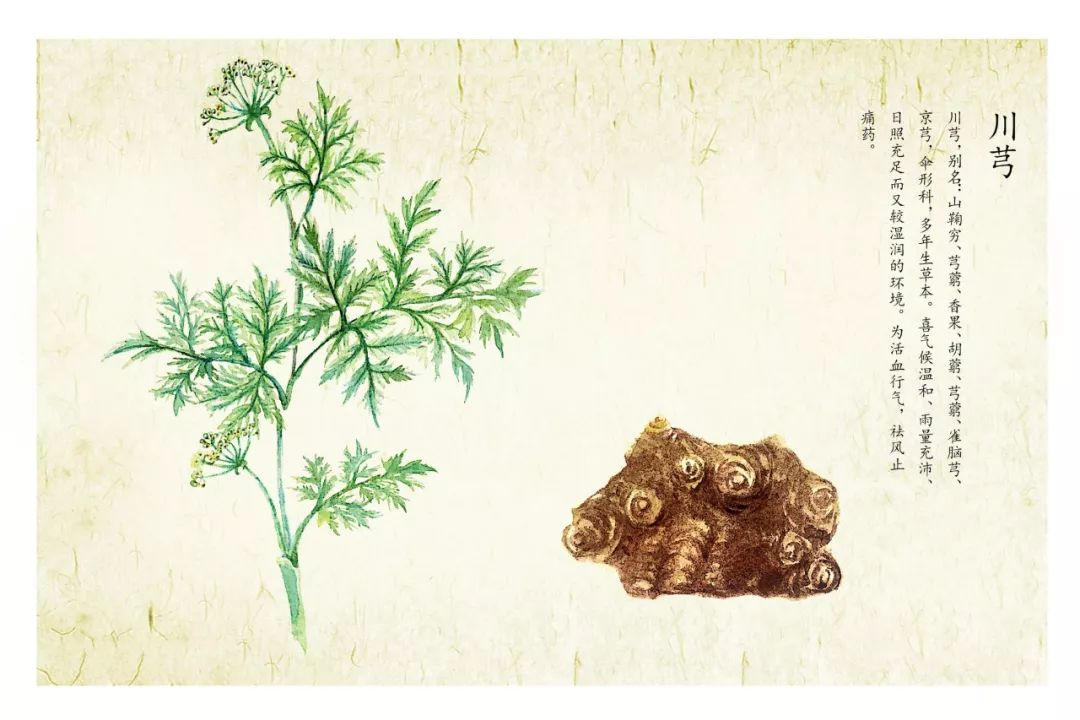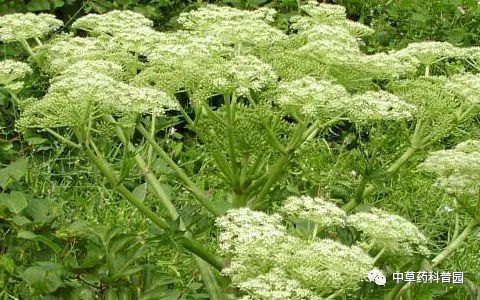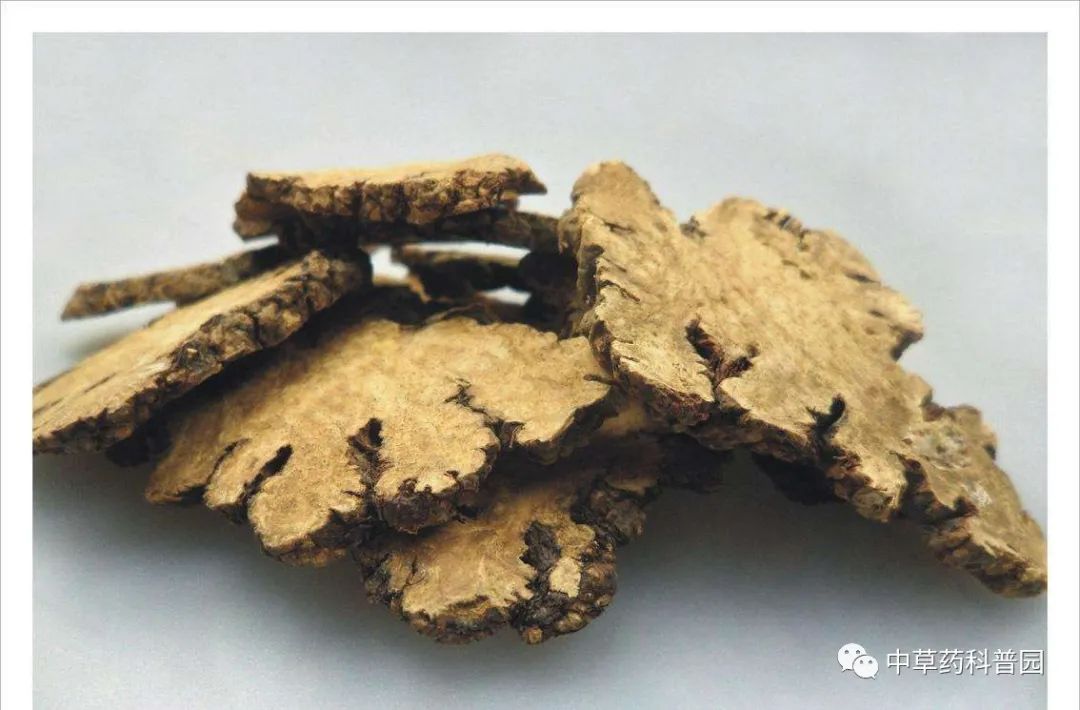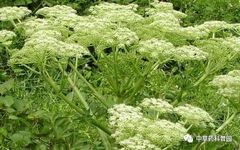 Chuanxiong Encyclopedia
Chuanxiong Encyclopedia
【Source】Chuanxiong is the dried rhizome of the plant Ligusticum chuanxiong, belonging to the Apiaceae family.
【Taste and Properties and Meridian Affinity】Pungent, warm. Enters the Liver, Gallbladder, and Pericardium meridians.
【Characteristics】This herb is pungent and warm, dispersing and moving, entering the blood and qi, ascending to the head and descending to the blood sea. It promotes blood circulation and qi movement, dispels wind, and alleviates pain. It is effective for pain due to blood stasis and qi stagnation, especially in cases of cold, and has been praised by predecessors as the “qi medicine of the blood,” particularly for headaches. It is best for conditions of wind-cold and blood stasis, while also applicable for wind-heat, wind-damp, and blood deficiency, hence the saying, “Headaches are never far from Chuanxiong.”
【Functions】Promotes blood circulation and qi movement, dispels wind, and alleviates pain.
【Indications and Symptoms】
1. Irregular menstruation, dysmenorrhea, amenorrhea, difficult labor, postpartum abdominal pain due to blood stasis.
2. Chest pain, pain in the hypochondrium, numbness of limbs, trauma, and swelling and pain from sores.
3. Headaches, rheumatic pain.
【Dosage and Administration】3-10g.
【Precautions】Due to its pungent and warm nature, it is not suitable for those with yin deficiency and excess heat, qi deficiency with profuse sweating, qi counterflow with vomiting, excessive menstruation, or hemorrhagic diseases.
【Origin】Mainly produced in Sichuan, Jiangxi, Hubei, and Shaanxi provinces. Mostly cultivated.
【Harvesting and Processing】Harvest in summer when the nodes on the stem are prominently protruding and slightly purplish. Remove stems and leaves, dry until semi-dry, then further dry by steaming, and remove the fibrous roots.

【Modern Pharmacological Research】
Chuanxiong contains volatile oils, alkaloids such as ligustrazine, and lactone components like ferulic acid, and various phenolic and organic acid compounds including ferulic acid, rhein, vanillin, and palmitic acid. Modern pharmacological studies indicate that Chuanxiong can inhibit vascular smooth muscle contraction, dilate coronary arteries, increase coronary blood flow, reduce peripheral vascular resistance, improve microcirculation, inhibit platelet aggregation, and has anti-thrombotic effects. It also promotes hematopoiesis in the bone marrow, has sedative, antispasmodic, immune-regulating, anti-radiation, and anti-tumor effects.
【Clinical Applications and Combinations】
1. For headaches due to colds, including both frontal and occipital headaches. Chuanxiong is pungent and aromatic, capable of ascending to the head, effectively dispelling wind and alleviating pain. It can be combined with Xi Xin (Asarum) and Bai Zhi (Angelica dahurica) for enhanced effect, or adjusted according to the meridian involved in the headache. For headaches caused by wind invasion, it can be combined with Jing Jie (Schizonepeta) and Fang Feng (Saposhnikovia) for wind-cold headaches; or with Ju Hua (Chrysanthemum) and Jiang Can (Silkworm) for wind-heat headaches.
2. For chest and hypochondriac pain, rheumatic pain, masses, sores, and trauma, as well as irregular menstruation, dysmenorrhea, and postpartum pain. Chuanxiong is warm and dispersing, promoting blood circulation and removing stasis, making it widely applicable for various conditions of blood stasis. It is particularly important for gynecological conditions. For irregular menstruation, dysmenorrhea, and amenorrhea, it is often combined with Dang Gui (Angelica sinensis); for rheumatic pain, it can be combined with Qiang Huo (Notopterygium) and Du Huo (Angelica pubescens); for masses, it can be combined with San Leng (Sparganium) and E Zhu (Curcuma zedoaria); for sores and trauma, it can be combined with Ru Xiang (Frankincense) and Mo Yao (Myrrh).

 Chuanxiong Culinary Recipes
Chuanxiong Culinary Recipes
1. Chuanxiong Stewed Duck: 10g of Chuanxiong, 20g of old ginger, half a duck, soy sauce, salt, cooking wine, sugar, and other seasonings to taste. Clean and slice the ginger, clean and cut the duck into pieces; heat oil in a pan, sauté the ginger until fragrant, add the duck pieces and stir-fry until slightly browned, add water, soy sauce, sugar, salt, cooking wine, and Chuanxiong, cover, and simmer on low heat for one hour until the duck is tender. This dish can dispel wind, alleviate pain, promote blood circulation, and is effective for women with blood deficiency and dizziness.
2. Chuanxiong Boiled Eggs: 6g of Chuanxiong, 2 eggs. Clean the eggshells, wash the Chuanxiong, soak for 10 minutes, then place both in a pot with adequate water, boil until the eggs are cooked, remove the eggs, peel them, and return them to the pot to simmer on low heat for 40 minutes. Consume the eggs and drink the broth. This dish promotes qi and blood circulation, suitable for dysmenorrhea due to qi stagnation and blood stasis, and should be consumed starting three days before menstruation.

 A Little Story about Chuanxiong According to legend, during the early Tang Dynasty, the Medicine King Sun Simiao traveled with his apprentice to gather medicinal herbs in Qingcheng Mountain, Sichuan. One day, they grew tired and rested in a pine forest. Suddenly, they saw a large female crane playing with several chicks. The Medicine King was captivated, but then heard the chicks cry out, and saw the female crane with its head down, trembling, and mourning. The Medicine King immediately understood that the crane was suffering from a serious illness.The next morning, at dawn, the Medicine King and his apprentice returned to the pine forest. Not far from the crane’s nest, the moans of the sick crane were clearly audible. After another day, they returned again, but the moans from the crane’s nest had ceased. Looking up, they saw several white cranes soaring in the sky, dropping a small white flower and some leaves that resembled carrot leaves. The Medicine King instructed his apprentice to collect them for preservation. Days passed, and the female crane had completely recovered, leading the chicks in play as before. The Medicine King observed that the white cranes often visited an ancient cave on the cliff at the mountain’s peak, where a patch of green grass grew, with flowers and leaves resembling those that had fallen from the crane’s beak. He deduced that the crane’s recovery was related to this plant. After experimentation, he discovered that this plant had the effects of promoting blood circulation, regulating menstruation, and dispelling wind and alleviating pain, and instructed his apprentice to take it down the mountain to treat patients accordingly, which proved to be effective. The Medicine King excitedly composed a verse: “Qingcheng is the best cave in western Sichuan. Where the immortal cranes pass, good medicine descends from the heavens. This medicine shall be called Chuanxiong!” Thus, Chuanxiong got its name.
A Little Story about Chuanxiong According to legend, during the early Tang Dynasty, the Medicine King Sun Simiao traveled with his apprentice to gather medicinal herbs in Qingcheng Mountain, Sichuan. One day, they grew tired and rested in a pine forest. Suddenly, they saw a large female crane playing with several chicks. The Medicine King was captivated, but then heard the chicks cry out, and saw the female crane with its head down, trembling, and mourning. The Medicine King immediately understood that the crane was suffering from a serious illness.The next morning, at dawn, the Medicine King and his apprentice returned to the pine forest. Not far from the crane’s nest, the moans of the sick crane were clearly audible. After another day, they returned again, but the moans from the crane’s nest had ceased. Looking up, they saw several white cranes soaring in the sky, dropping a small white flower and some leaves that resembled carrot leaves. The Medicine King instructed his apprentice to collect them for preservation. Days passed, and the female crane had completely recovered, leading the chicks in play as before. The Medicine King observed that the white cranes often visited an ancient cave on the cliff at the mountain’s peak, where a patch of green grass grew, with flowers and leaves resembling those that had fallen from the crane’s beak. He deduced that the crane’s recovery was related to this plant. After experimentation, he discovered that this plant had the effects of promoting blood circulation, regulating menstruation, and dispelling wind and alleviating pain, and instructed his apprentice to take it down the mountain to treat patients accordingly, which proved to be effective. The Medicine King excitedly composed a verse: “Qingcheng is the best cave in western Sichuan. Where the immortal cranes pass, good medicine descends from the heavens. This medicine shall be called Chuanxiong!” Thus, Chuanxiong got its name.

